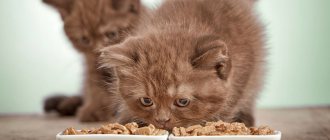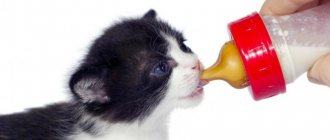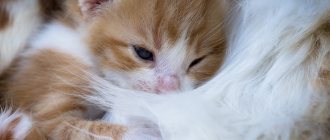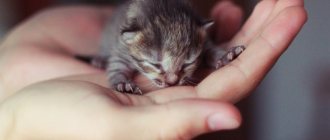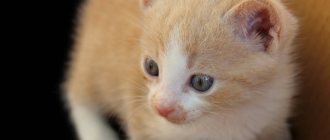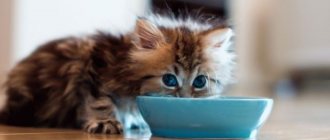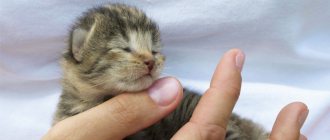When a kitten appears in the house, the owners stock up on fresh milk, food and bowls, but he refuses to eat, although he is hungry. What to do in such a situation? Of course, you need to teach the kitten to eat on its own.
Problems with nutrition most often occur in those kittens that were given to their owners too early to be raised and taken away from their mother before he learned to eat on his own. From the age of three weeks, you can already accustom your kitten to feeding on its own. You need to start learning with milk.
Heat the milk a little and pour it into a bowl. How to feed a three-week-old kitten? Place the bowl next to the kitten and dip its face in the milk - it will be forced to lick it and taste the milk. Try until the kitten becomes interested and starts eating on its own. Sometimes kittens refuse to drink because the bowl is very low and the kitten has to bend over, so keep an eye on this issue and place the bowl on a stand.
When the baby learns to drink milk, offer him to eat meat pate for kittens. You need to put a little pate on your finger and bring it to the baby’s mouth - he will smell the smell and want to try new food. If the kitten licked the pate, then put some in a bowl. The kitten should not be given dry food or solid food in large pieces; try to grind, chop all the food and gradually give it in small portions - for testing.
What to feed a three-week-old kitten? Food for a kitten is pureed soups, meat broths, milk, meat in small pieces (boiled only), special food for kittens and canned food. Food should not put too much strain on the kitten’s stomach, however, it is necessary to eat. You can give your cat a hard-boiled egg yolk, broth, boiled potatoes, boiled fish and boiled beef, and calcined cottage cheese.
Special canned food for kittens is balanced and softens the gastrointestinal tract. Be sure to give your baby water - let him drink as much as he needs; There are kittens that drink little, and there are kittens that don’t drink much. Cats are very sensitive to the cleanliness of their bowls, so make sure to wash all of your kitten's bowls regularly. Change the water regularly to fresh water - it encourages the kitten to drink.
How can you tell if your pet is eating normally? Only by tray. If your baby goes to the tray regularly, it means you are feeding him normally. Each animal has its own food consumption rate.
It is best not to introduce your kitten to dry food, as later problems with the intestines and stomach may arise.
Feeding a newborn kitten is a rather complex and difficult process. The reason is that he is just beginning to master unfamiliar food, and perhaps he will not like some food at all.
To correctly determine whether a kitten is full or not, pay attention to its behavior: a hungry cub squeaks all the time, crawls around its mother, or sucks the finger extended to it, while the well-fed ones suck the cat’s milk or sleep.
- What to feed a kitten for 3 weeks?
- What to feed a kitten for 3 weeks?
A hungry kitten needs to be fed, and motherless babies also need feeding.
What to feed a kitten at 3 weeks?
The fact is that the baby does not tolerate regular cow's milk well, since it has a different taste than cat's milk, and also contains 10 times less protein. Milk substitute, which can be purchased at a pet store, gives good results. If the kitten does not want milk, you can try giving him infant formula, which is specially adapted to the needs of the growing body.
The most universal recipe: mix 0.5 liters of concentrated milk, 4 teaspoons of sugar and egg yolk.
For a 3-week-old kitten, you can start giving a little finely chopped beef, fish, and low-fat cottage cheese. Keep an eye on your baby's stool. If it is liquid, then the milk can be diluted with water to reduce the concentration of lactic acids in the mixture.
Your kitten: 5 weeks
- Physical development : At 5 weeks of age, the kitten's teeth continue to develop. The premolars will begin to emerge. The eyes will be blue, and the ears will grow and become pointed. The claws will be retractable.
- Behavioral Development : Five week old kittens will run and play confidently. They will develop communication skills with people and other animals. Their self-care skills will improve. By this age, they will have perfected their use of the litter box.
- Average temperature : 37-38 ℃. At this age, a heat source is no longer required if the environment is at a comfortable temperature of 21-23 degrees.
- Average weight : 550-650 grams.
- Care Information : Five week old kittens, if healthy, can begin the weaning process. Kittens should be given adequate amounts of "liquid manure" or wet kitten food, in addition to their mother's milk or bottle if they are orphaned. If weaning occurs, food and water should be provided at all times. Always provide supplemental nutrition and ensure the kitten maintains a healthy weight and body shape during weaning. Always provide a shallow litter box.
Feeding methods
To feed your kitten you will need a small bottle and a pacifier. You can also use a syringe without a needle. Food should be heated to a temperature of 38 degrees. Make sure your kitten sucks milk on its own.
- What to feed a kitten for 3 weeks?
What to feed a kitten for 3 weeks?
Do not forcefully administer it, otherwise the baby may choke. You also need to follow the rule: do not give milk to the kitten through a wide opening, as it can get into the respiratory tract, and the kitten will get pneumonia. When feeding, hold your baby in your arms to make him more comfortable.
Feeding a 3-month-old kitten should be done 6-7 times a day, with daytime breaks of 2-3 hours, and night breaks of 5-6 hours.
Over time, the frequency of feedings decreases, and at the same time, the amount of food fed at a time increases.
Visit the profile section of our Feeding Cats forum or leave your feedback in the comments below. More opinions means more useful information, it will be useful to someone. If there are good and interesting videos on the topic of the article, write and I will insert them into this publication.
- Kitten 3 weeks care
- 3 cats 2 months Mother.
- Adorable British kittens, girl and.
Reviews
please help: a 6 year old cat gave birth to a kitten. She was with him and me for 3 weeks. and yesterday I went to the sea. and I arrive she’s not there. what to do with a 3 week old kitten?
I have been feeding the kitten since she was 3 days old. Mom didn't get milk, 2 brothers died of hunger. This child survived and we began to feed him plain milk from the store. We feed from a syringe 3 times before lunch and 3-4 times after 17:00. I feed for 3 weeks. Now I give complementary foods with meat puree “Tema”. I thought it would be difficult. It's OK. Do not be afraid! You never know what you can do till you try
Kitten 3 weeks old, weaned from the cat because... hides, carries away... started feeding milk with yolk, as advised... 4th day no stool.. stomach is quite dense.. abdominal massage somehow does not help... now we are trying to warm the stomach with dry heat... Tell me what it could be and how to deal with it fight... PLEASE...
Is it possible to feed a 4 week old kitten “Tyoma” (Tyoma “Veal”)
Here is the first photo of the miracle
Julia is like a kitten. Did he survive?
Colleagues and sympathizers! I ask for your advice, help and support! I have a cat. He is 12 years old. On September 26, I picked up a kitten. I feed him 0+. And so... I’ve had it for 11 days, I picked up this unfortunate miracle toothless, with terrible conjunctivitis, and it slept for 6 hours, ate 2.5 g each. And I’ve already identified its eyes. Now he walks staggeringly and sometimes his head weighs him down and he tumbles hilariously. The problem is that I have never even seen such kittens. And now I have to feed him from a syringe and now from a bottle. But that's not the problem. I want to start giving 0% cottage cheese and starter food for kittens. Is not it too early? Prehistory in a nutshell. On cold rainy days, a yard cat abandoned her kittens. My husband and I washed one of the dirt and fleas, I, a fool, brought the second one back to life and gave it to a really good woman, but he didn’t live to see her until dawn... that’s such a sad story. But now about the survivor who sleeps in a shoebox. And so, tell me... most likely the baby (I don’t know what gender it is) is three weeks old now. The fangs are being cut, she is tearing my hands with her claws and teeth needles. So two questions. 1. When can you feed and with what?? Question 2: why is there no poop? The abdomen is soft, not worried. The butt is not sore. Maybe some liquid is coming out, but I can’t see it. I just don't know how it should be. Maybe when I start giving cottage cheese and starter food, then poop that looks like poop will appear? Yes... actually why does it come out? I stroke the belly, stimulate the butt and it pees copiously into my palm on a napkin. In general, I earn money as a cat))) and my old man not only doesn’t want to acknowledge her, he would strangle her if it weren’t for my constant presence♀️ Guys! Advice is needed sooooo much! I am a delitant, I am a pie with nothing...
Your kitten: 2 weeks
- Physical Development : At 2 weeks of age, kittens' eyes will be fully open and blue. They will have poor eyesight and will not be able to see over long distances. The ear canals will be open, and the ears will be small and round, like a bear cub. If you open the kitten's mouth, you will find that there are still no teeth. The claws will still not extend.
- Behavioral development : Two-week-old kittens will become more coordinated and begin to take their first steps. They will be unsteady on their feet and uncoordinated. Kittens at this age may be curious about the world around them, will not yet play and will spend most of their time sleeping.
- Average temperature : 36-37 ℃. It is important to provide a gentle heat source to keep the kitten warm and stable. At this time, the kitten's ambient temperature should be about 26 degrees.
- Average weight : 250-350 grams
- Care information : Two-week-old kittens live permanently with their mother. If the mother is not present, they should be bottle-fed and kitten formula every three to four hours by a knowledgeable caregiver, encouraged to go to the bathroom, and maintained at an appropriate temperature. Kittens as young as two weeks old may begin to develop degwords.
Cat milk replacers
The main food for kittens at the age of 3 weeks is still mother's milk. But if babies are raised artificially, the human breadwinner should pay special attention to choosing a suitable milk formula.
Industrial feed
The pet industry offers special dry mixtures containing all the ingredients necessary for infant kittens. According to the attached instructions, immediately before use, a small amount of the mixture is diluted with warm water and mixed thoroughly.
It is recommended to purchase products from well-known companies that guarantee nutritional value, good digestibility and excellent taste:
- Royal Canin Babycat Milk;
- Nutri-Vet Kitten Milk;
- Beaphar Kitty-Milk;
- Kittenmilch cdVet.
Natural dairy products
Many owners prefer to prepare food suitable for feeding 3-week-old kittens at home, believing that this will be healthier for the kittens.
It should be remembered that babies do not particularly like regular cow's milk, having a different taste and smell, and, in addition, it contains 3 times less protein and 2.5 times less fat.
To prepare the nutritional mixture, you can use one of the recipes:
- Combine 200 g of whole cow's and goat's milk, add 2 chicken egg whites, mix thoroughly.
- Pour 0.5 tsp into goat milk (100 ml). oil (it is better to take refined corn) and add half the yolk, mix until a homogeneous consistency is obtained.
- Mix warmed cow's milk (250 ml), bone meal (on the tip of a teaspoon), condensed milk (50 ml, without sugar) and boiled water (25 ml). Then the mixture must be strained well so that there are no lumps and cooled.
- Add a drop of Trivit vitamin complex to natural 9% cream (100 ml).
- Dilute the milk powder in fennel broth until it becomes liquid sour cream, add ¼ part of natural cream.
Your kitten: 6 weeks
- Physical Development : At 6 weeks of age, a kitten's teeth begin to reach the final stage of early development. The molars will begin to appear. The eyes will still be blue, and vision and hearing will be fully developed.
- Behavioral Development : Six-week-old kittens will confidently interact with peers, fight, attack and defend themselves. They will be curious about their surroundings and will be eager to explore. They will improve their self-care skills. At six weeks old, kittens become coordinated enough to jump off furniture and land on their feet.
- Average temperature : 37-38 ℃. At this age, a heat source is no longer required if the environment is at a comfortable temperature of 21-23 degrees.
- Average weight : 650-750 grams.
- Care Information : Kittens should receive adequate amounts of wet food after weaning. Always provide access to water, food and a shallow litter box. At six weeks, kittens should receive their first FVRCP vaccine to protect against viruses (rhinotracheitis, calicivirus and panleukopenia).
© shutterstock
First feeding
Starting from 3 weeks of age, kittens begin to be offered “adult” food. To avoid overloading the digestive tract, do this very carefully and gradually.
Unusual food is given little by little, starting with feeding once a day and increasing the number of complementary foods to 3 times a day over 7-10 days.
All food is given to babies in the form of warm puree.
Homemade food
You can start feeding small pets with natural protein products. The most suitable ones would be:
- Shaved veal. To obtain scraping, meat that has been frozen for 24-48 hours is scraped with a knife on a cutting board to form lamellar pieces. The initial size of the meat portion is comparable to the size of a pea.
- Baby meat puree in small jars.
- Liquid, well-cooked milk porridge (rice and oatmeal).
- Cream with a fat content of 9-10%.
- Fresh low-fat cottage cheese without additives.
Industrial rations
Special dry food and canned food are developed for small kittens in the 1st growth phase and ensure a safe transition from dairy food to adult food. They contain proteins, fats, vitamins and minerals that ensure the proper development of the kitten, but do not create a burden on the immature digestive system.
According to breeders, the leader in this area is Royal Canin Babycat 34.
Its small pieces have a delicate texture, quickly swell in water and turn into a nutritious paste.
Also watch the video on how to feed a newborn kitten without a cat:
Your kitten: 7 weeks
- Physical Development : All baby teeth will appear by 7 weeks of age. At this age, the kitten's eye color will change and the adult eye color will begin to appear. Kittens' testicles will begin to descend at about 7 weeks.
- Behavioral Development : Seven week old kittens will experience a burst of energy. Sleep will decrease and time spent playing will increase. At this age, kittens can run, climb cat trees, and confidently jump off furniture.
- Average temperature : 37-38 ℃. At this age, a heat source is no longer required if the environment is at a comfortable temperature of 21-23 degrees.
- Average weight : 750-850 grams.
- Care Information : Kittens should receive an adequate amount of wet kitten food and may have dry kitten food as a supplement. Always provide access to water, food and a shallow litter box.
Rules for feeding kittens aged 3 weeks
Raising infant kittens, first of all, comes down to strict adherence to the feeding schedule. The tiny stomach is not able to digest a large portion, and the delicate intestines are not able to digest rough food. In order for babies to grow healthy and strong, the owner should follow a number of rules:
- Babies need to be fed 6 times a day, taking a break at night for 5 hours.
- If kittens have enough food, they will sleep peacefully most of the time, while hungry babies are restless and whiny. They crawl all the time in search of food and, having caught a human finger, will try to suck it.
- All food for babies should be exclusively fresh: a new portion is prepared from milk replacer powder each time, and natural milk formula is stored in the refrigerator for no more than 48 hours.
- Kittens receive their main milk supply from a bottle with a nipple or through a pipette with a hole attached to a syringe.
- The first mushy complementary food is given from the fingers. But if the baby does not want to try the proposed dish on his own, you need to carefully open his mouth and spread a small amount of warm puree across the palate. The procedure is repeated until the kids get used to the taste of the new food.
- Gradually, kittens are taught to eat from a bowl. It is recommended to use porcelain or metal utensils, since cheap plastic has an unpleasant odor and can react chemically with food.
- All nipples, bottles and bowls are thoroughly washed and dried after use.
- To ensure that the kitten's intestines are emptied regularly, a circular tummy massage is performed after each feeding.
- If stool is retained for more than 3 days, it is recommended to give the kitten children's Duphalac as a mild laxative.
- For loose stools, before each feeding, babies are given Bifidumbacterin diluted in water, or some other pharmaceutical preparation containing bifidobacteria.
After the kittens are 1 month old, you can gradually expand the range of allowed foods, monitoring the individual reaction of the body.
Your kitten: newborn
- Physical development : Newborn kittens have their eyes closed and ears folded. They will have no teeth, and their gums, nose and paws may be bright pink. They do not yet have a gag reflex or the ability to thermoregulate. The umbilical cord will be attached and fall off on its own between 4 and 5 days of age. The claws will not extend. At this age they can neither hear nor see; they can navigate the world around them only by smell and by seeking warmth and comfort.
- Behavioral Development : Newborns will sleep most of the day. Newborns cannot defend themselves or walk, but can move around by crawling. A healthy newborn will squirm and meow when picked up.
- Average temperature : 35-36 ℃ at birth. It is important to provide a gentle heat source to keep the kitten warm and stable. The kitten's ambient temperature should be between 30-32 degrees Celsius at this time.
- Average weight : 50-150 grams
- Care Information : Newborn kittens are with their mother at all times, as mothers will provide food, cleaning, warmth, and bath support. If the mother is not present, they should be bottle-fed and kitten formula every two hours under the supervision of knowledgeable persons, encouraged to go to the toilet, and maintained at an appropriate temperature.
© shutterstock
Additional care for newborn kittens
When a kitten is left without a mother, it is important not only to provide adequate nutrition and good living conditions, but also other care. A cat, licking the baby's belly, stimulates the reflexes of urination and defecation, so doctors recommend carrying out the procedure yourself using a gentle finger massage - circular movements are made in the pelvic area, where the urethra and anus are located.
If the baby cannot empty his bowels, an enema is used. The manipulation is carried out using a 5 ml syringe without a needle, which is filled with warm water. The tip is lubricated with castor oil or Vaseline and inserted into the rectum, after which the contents of the syringe are injected.
1111
How and when to introduce a kitten's first complementary foods?
The first feeding includes dairy products (for kittens that have been fed by their mother). You should start with 2 teaspoons of milk, dry, medium fat, diluting it with warm water and adding honey or a pinch of sugar (10 g/l). Use a small spoon to pour the milk directly into the cat's mouth. Gradually, every day you need to increase the amount of milk by 1 spoon. You can also give milk porridge prepared in the same way as for baby food, or as in the example with oatmeal: it is diluted with whole milk with the addition of cream and a chicken egg (all this must be mixed into a homogeneous mass). Dairy products are given from a bowl or from a spoon, and then from a bowl. If your kitten can't figure out how to lap milk, lubricate its mouth with a drop of milk. Your little pet will understand what's going on and will begin to lap from the bowl, and soon, obeying the feeling of hunger, he will eat from the bowl himself.
To replace cat milk, you can use the following recipe:
0.5 liters of concentrated milk, egg yolk and 4 teaspoons of granulated sugar.
At approximately the same time, at 3-4 weeks of age, you can gradually feed kittens (both “natural” and “artificial”) with other products or soak a few granules of dry food first in warm milk and then in water. This will depend on the type of feeding you prefer for your pet: natural feeding or feeding commercially prepared food. This must be done at the same time of day. A pea-sized ball is formed from raw or cooked meat and placed in the kitten's mouth. After the first 2 weeks of feeding, you can gradually diversify the menu: 2 times a week, add egg yolk and dry yeast to the milk, give porridge from chicken or fish with rice water, finely chopped or ground beef (lean); cottage cheese and entrails. Kittens simply need dairy food in the first 4 months. If the baby has loose stools, regular milk should be replaced with concentrated milk, diluted with warm boiled water in a ratio of 1:2. At the age of 3-5 weeks, kittens are weaned from their mother, and they eat baby food in a ratio of 4/6 - meat with carbohydrates, 2/6 - milk with carbohydrates. From 5 months of age, kittens can be switched to the diet of adult animals, but with 3 meals a day.
If you have purchased a kitten, be sure to ask the cat’s owner what kind of food he gave to the animals.
Sometimes during weaning, kittens may develop digestive problems. In this case, add a few teaspoons of warm chamomile tea to the sick animal's milk or inject it into the cheek using a syringe without a needle. You can also introduce drugs with bifidobacteria.
Feeding mode
The feeding regimen for different types of feeding is approximately the same. Up to 3 months, feed your little pet 6 times a day, from 4 to 5 months - 4-5, from 6 to 9 months - 3-4 times a day, from 9 to 12 months - 1-2 times a day. It is important that the food is warm. Kitten food is high in calories, high in protein and other nutrients. Thus, kittens up to 8 weeks of age require 628 J of energy per day, at the age of 3 months - 837 J, 4 - 963 J.
With a natural type of feeding, it is necessary to focus on the following proportions: 60% high-calorie protein, 10% fat, 30% other ingredients, controlling the level of calcium, phosphorus and taurine. For example, a menu for a cat aged 6 months with a body weight of 2 kg may consist of 100 g of lean boiled beef, 10 g of sardines in oil, 20 g of boiled rice. All this is finely chopped and mixed with meat broth.
The following products serve as the basis for a kitten’s growth:
- raw, boiled and finely chopped meat (beef, poultry, rabbit) and offal,
- soft raw bones and cartilage in small quantities;
- boiled fish without large bones,
- dairy products (cottage cheese, kefir, yogurt, yogurt),
- eggs,
- cereals (rice, buckwheat, millet),
- boiled in milk,
- fish or meat broth,
- vegetables, vitamins.
How to properly feed a blind kitten
To feed a one-week or two-week-old kitten, you need to purchase a pacifier and bottle from a veterinary pharmacy.
An ordinary medical syringe without a needle will also work.
You can use a rubber tip from a pipette, pierced with a hot needle and placed on a small vial.
It is better to feed a kitten up to one month of age from a nipple
Firstly, the sucking instinct is satisfied, and secondly, the risk of aspiration of the respiratory tract with milk or formula is reduced, which can lead to pneumonia.
Feeding from a pipette or syringe requires great care.
Since babies' immunity is still weak, any infection can be fatal.
Important! Cleanliness and sterility of nipples and bottles is an integral rule that must be strictly followed.
While the cub is eating, it is advisable to stroke its head and back and talk to it quietly.
There is no need to limit milk or formula - the suckling's face should be in milk, and the tummy should be rounded.
After feeding, it is advisable to hold the suckling upright.
When the blind kitten is full, he begins to fall asleep, and milk bubbles appear from his mouth.
He needs to wipe his face with a napkin soaked in warm water.
Many people are interested in whether it is possible to determine how much food the baby has received?
It’s possible - well-fed babies calmly fall asleep, but hungry ones get restless, crawl, and squeak.
If you give them a finger, they start sucking it.
